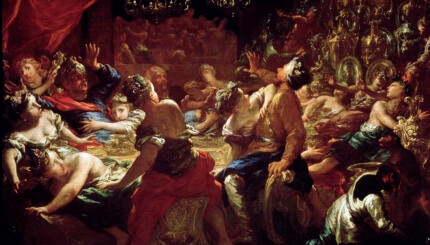Commentary on Parashat Bechukotai, Leviticus 26:3-27:34
There is something profoundly unsettling about Bechukotai. It seems to posit a world that we know, empirically, does not exist. It claims that there is a direct correlation between our actions and the natural order of the universe. Leviticus 26:3-5 promises unambiguously: “If you follow My laws and faithfully observe My commandments, I will grant you rains in their season … you shall eat your fill of bread….” Verses Leviticus 14-16 warn just as clearly: “But if you do not obey Me and do not observe all these commandments … I will wreak misery upon you ….” The seeming system of reward and punishment that these biblical passages proclaim appears to contradict the troubling reality that we witness, in which good people suffer, and evil people often prosper.
READ: When Bad Things Happen to Good People
Passages like these seem to provide justification for those who reject both faith and God. How often do we hear, in the face of personal trauma or tragedy, “I can no longer believe in God” or “I can’t believe in a God who would do this”? How are we to understand God’s threats and promises?
According to the biblical scholar Nehama Leibowitz, our ancestors regarded blessings and curses, such as those in B’hukotai, as forms of prayer: These are the things that people hoped for, even willed to happen, in their longing for a world in which justice would visibly prevail. Perhaps this portion is telling us, in its own theological language, that there is a moral order to the universe that is intrinsically connected to the natural order of the universe — and that the two orders are mutually dependent. In these teachings, it is as if God gives humankind every opportunity to discern that human action is intrinsic, and essential, to the proper functioning of the cosmos.

Help us keep Jewish knowledge accessible to millions of people around the world.
Your donation to My Jewish Learning fuels endless journeys of Jewish discovery. With your help, My Jewish Learning can continue to provide nonstop opportunities for learning, connection and growth.
Over and over again, the Torah enjoins us to act, to do, and to be because we “were slaves to Pharaoh in Egypt” (Deuteronomy 6:21), because we “know the feelings of the stranger” (Exodus 23:9), and through these experiences have been given the opportunity to glimpse this truth. This is why we were chosen to bear witness to God’s revelation that “I, your God mil” am holy” (Leviticus 19:2).
We are created in God’s image and we, as God’s partners, were chosen for a sacred task. This is our heritage and our responsibility; this is what it means to complete the work of Creation. But what if we forget, neglect, or ignore our sacred task of following the commandments?
The catalog of threats and promises is a biblical way to explain how intimate the connection of the natural realm of the universe is to the moral realm. The two realms do not function independently of each other. There is a moral order to the universe as surely as there is a more easily observable natural order of “rains in their season.”
And it is in the moral realm where God cannot function alone. God never could — and so kept looking for partners. What did we expect of a God who created the natural universe? That the moral dimension was an afterthought? Our sages believed it pre-existed. God did not neglect the moral realm. On the contrary, humankind did. God kept expecting humankind to behave morally and was constantly disappointed with Adam, with Noah, with the generations after the Flood. Finally, God found Abraham, the person who engaged God as an equal on ethical ground: “Must not the Judge of all the earth do justly?” (Genesis 18:25), and the process of Revelation began.
The essential unity of all aspects of God’s Creation appears as well in Lurianic Kabbalah’s formulation of the universe. Isaac Luria‘s theory of Sb’uirat Hakeilim (Shattering of the Vessels) seeks to explain the brokenness of our world, and to advance the means to restore it to its original unity. For Luria in the 16th century, it was the great cosmic shattering that had brought about our exile from God and from God’s Creation. Luria not only understood the primordial unity of God’s intention but also yearned for a return to it. In God’s promise of “rains in their season [and presence] in your midst,” Luria could see the opportunity for humankind to repair the world, to release the sparks, to play a role in the restoration of the universe through the performance of mitzvot.
In Judaism, the mystic does not seek to transcend or deny the material world. Rather, the mystic’s goal is the objective of this Torah portion: to restore the world, materially and spiritually, to a “single divine reality.” As Lawrence Fine describes that goal in his study of Luria, Physician of the Soul, Healer of the Cosmos (2003), it is the “dream that collective human effort can mend a broken world.” This is the vision of B’chukotai.
In these final verses of the Book of Leviticus, God describes-in the most tactile, physical, understandable terms possible-the relationship between God’s Creation and humankind’s responsibility. It is simultaneously bribe and promise, exhortation and encouragement. At the foundation of it all is the essential understanding of Torah: the physical and ethical dimensions of God’s Creation are wholly dependent upon each other, and we ignore that relationship at our peril. There is no quid pro quo for individuals in the world–God’s scheme is far grander and more subtle than that. The issue is not one of personal reward and punishment. It is the unity of God, the unity of the prophetic vision as rendered in the Reform liturgy: “On that day, all the world shall be One and God’s name shall be One” (Zechariah 14:9).
It is the ultimate fulfillment of Torah — as expressed in Leviticus 26:46: “These are the laws, rules, and torot that God established beino uvein b’nei Yisrael (in relationship with the Children of Israel).” This is the partnership that must one day bring about the fulfillment of our hopes, dreams, and strivings-the sparks released as heaven and earth, heart and mind and soul are united at last.
Reprinted with permission from The Torah: A Women’s Commentary, edited by Tamara Cohn Eskenazi and Andrea L. Weiss (New York: URJ Press and Women of Reform Judaism, 2008).



